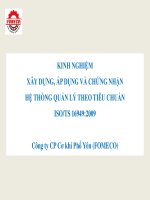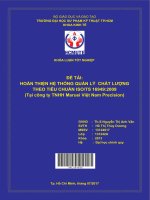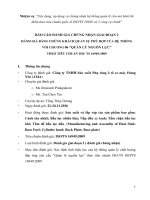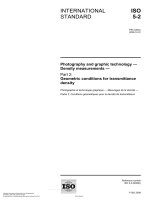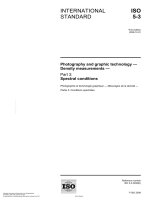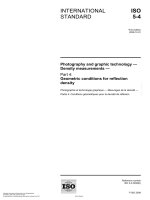Tiêu chuẩn iso 00877 2 2009
Bạn đang xem bản rút gọn của tài liệu. Xem và tải ngay bản đầy đủ của tài liệu tại đây (378.63 KB, 12 trang )
INTERNATIONAL
STANDARD
ISO
877-2
First edition
2009-06-01
Plastics — Methods of exposure to solar
radiation —
Part 2:
Direct weathering and exposure behind
window glass
Plastiques — Méthodes d'exposition au rayonnement solaire —
Partie 2: Exposition directe et exposition derrière une vitre en verre
Reference number
ISO 877-2:2009(E)
© ISO 2009
ISO 877-2:2009(E)
PDF disclaimer
This PDF file may contain embedded typefaces. In accordance with Adobe's licensing policy, this file may be printed or viewed but
shall not be edited unless the typefaces which are embedded are licensed to and installed on the computer performing the editing. In
downloading this file, parties accept therein the responsibility of not infringing Adobe's licensing policy. The ISO Central Secretariat
accepts no liability in this area.
Adobe is a trademark of Adobe Systems Incorporated.
Details of the software products used to create this PDF file can be found in the General Info relative to the file; the PDF-creation
parameters were optimized for printing. Every care has been taken to ensure that the file is suitable for use by ISO member bodies. In
the unlikely event that a problem relating to it is found, please inform the Central Secretariat at the address given below.
COPYRIGHT PROTECTED DOCUMENT
© ISO 2009
All rights reserved. Unless otherwise specified, no part of this publication may be reproduced or utilized in any form or by any means,
electronic or mechanical, including photocopying and microfilm, without permission in writing from either ISO at the address below or
ISO's member body in the country of the requester.
ISO copyright office
Case postale 56 • CH-1211 Geneva 20
Tel. + 41 22 749 01 11
Fax + 41 22 749 09 47
Web www.iso.org
Published in Switzerland
ii
© ISO 2009 – All rights reserved
ISO 877-2:2009(E)
Contents
Page
Foreword............................................................................................................................................................ iv
1
Scope ..................................................................................................................................................... 1
2
Normative references ........................................................................................................................... 1
3
Principle ................................................................................................................................................. 1
4
Apparatus .............................................................................................................................................. 1
5
Test specimens ..................................................................................................................................... 3
6
Conditions of exposure of the test specimens.................................................................................. 4
7
Exposure stages ................................................................................................................................... 4
8
Procedure .............................................................................................................................................. 5
9
Expression of results ........................................................................................................................... 6
10
Test report ............................................................................................................................................. 6
© ISO 2009 – All rights reserved
iii
ISO 877-2:2009(E)
Foreword
ISO (the International Organization for Standardization) is a worldwide federation of national standards bodies
(ISO member bodies). The work of preparing International Standards is normally carried out through ISO
technical committees. Each member body interested in a subject for which a technical committee has been
established has the right to be represented on that committee. International organizations, governmental and
non-governmental, in liaison with ISO, also take part in the work. ISO collaborates closely with the
International Electrotechnical Commission (IEC) on all matters of electrotechnical standardization.
International Standards are drafted in accordance with the rules given in the ISO/IEC Directives, Part 2.
The main task of technical committees is to prepare International Standards. Draft International Standards
adopted by the technical committees are circulated to the member bodies for voting. Publication as an
International Standard requires approval by at least 75 % of the member bodies casting a vote.
Attention is drawn to the possibility that some of the elements of this document may be the subject of patent
rights. ISO shall not be held responsible for identifying any or all such patent rights.
ISO 877-2 was prepared by Technical Committee ISO/TC 61, Plastics, Subcommittee SC 6, Ageing, chemical
and environmental resistance.
Together with the other parts (see below), it cancels and replaces ISO 877:1994, which has been technically
revised.
ISO 877 consists of the following parts, under the general title Plastics — Methods of exposure to solar
radiation:
⎯
Part 1: General guidance
⎯
Part 2: Direct weathering and exposure behind window glass
⎯
Part 3: Intensified weathering using concentrated solar radiation
iv
© ISO 2009 – All rights reserved
INTERNATIONAL STANDARD
ISO 877-2:2009(E)
Plastics — Methods of exposure to solar radiation —
Part 2:
Direct weathering and exposure behind window glass
1
Scope
This part of ISO 877 specifies a method for the direct exposure of plastics to solar radiation (method A) and a
method for the exposure of plastics to glass-filtered solar radiation (exposure behind window glass)
(method B). The purpose is to assess property changes produced after specified stages of such exposures.
General guidance concerning the scope of ISO 877 is given in ISO 877-1:2009, Clause 1.
2
Normative references
The following referenced documents are indispensable for the application of this document. For dated
references, only the edition cited applies. For undated references, the latest edition of the referenced
document (including any amendments) applies.
ISO 877-1: 2009, Plastics — Methods of exposure to solar radiation — Part 1: General guidance
ISO 4582, Plastics — Determination of changes in colour and variations in properties after exposure to
daylight under glass, natural weathering or laboratory light sources
ASTM G 24, Standard Practice for Conducting Exposures to Daylight Filtered Through Glass
3
Principle
General guidance is given in ISO 877-1:2009, Clause 4.
4
4.1
Apparatus
General requirements
Refer to ISO 877-1:2009, Subclause 5.1, for general requirements.
When installed, the racks employed in test methods A and B shall be capable of providing the desired angle of
inclination (see 6.1) and shall be such that no portion of any test specimen is closer than 0,5 m to the ground
or to any other obstruction. Specimens may be mounted directly on the rack or in suitable holders which are
then affixed to the rack. Mounting fixtures shall be secure, but shall apply as little stress as possible to the
specimens and shall permit shrinkage, expansion or warping to occur without constraint, as far as possible.
In some cases, the object to be exposed is intended to be in direct contact with the ground (e.g. when entire
vehicles are exposed). In these cases, the requirements for minimum distance between the specimens and
the ground do not apply.
© ISO 2009 – All rights reserved
1
ISO 877-2:2009(E)
4.2
Test fixture for exposures using method A
The design of the specimen rack shall be suited to the types of specimen being exposed, but for many
purposes a flat frame mounted on a support is suitable. The materials used to construct the frame shall
conform to the requirements given in ISO 877-1:2009, Subclause 5.1. All materials used for the test fixture
shall be corrosion-resistant without the need for surface treatment. Aluminum alloys 6061T6 and 6063T6 and
stainless steel have been found suitable for use in most locations. Untreated wood may be acceptable for use
in very dry locations. The test fixture may be adjustable with respect to both solar altitude (i.e. tilt) and azimuth.
4.3
Test fixture for exposures using method B
The test fixture shall consist of an open-bottomed box with a framed cover of e.g. window glass, windscreen
glass or automotive side-window glass. The box shall be fitted with a specimen rack that is positioned in a
plane parallel to that of the glass cover and on which specimens may be mounted directly or in suitable
holders. The materials used to construct the box and the rack to which the specimens are attached shall
conform to the requirements of ISO 877-1:2009, Subclause 5.1. The test fixture may be adjustable with
respect to both solar altitude (i.e. tilt) and azimuth. A schematic diagram of a set of acceptable under-glass
exposure cases is shown in Figure 1.
Sufficient space between the cover and the rack is necessary to ensure adequate ventilation; a minimum of
75 mm has been found suitable. To minimize shadows, the usable exposure area under the glass shall be
limited to the area of the glass cover reduced by the distance from the cover to the specimens.
The glass used for the cover shall be flat, uniformly transparent and without defects. For exposures under
building-window glass, the glass cover shall be a piece of non-laminated, transparent flat glass. In order to
reduce variability due to changes in UV transmission of glass, all new glass shall be pre-aged for a period of
3 months. The thickness of the glass shall be 2 mm to 3,2 mm. Refer to ASTM G 24 for guidance on glass
pre-ageing, routine maintenance and the lifetime of such glass.
Other types of glass or glazing materials may be used as agreed upon by the interested parties.
NOTE 1
Exposure under glass may give rise to different results compared to exposure to the open atmosphere
because of a difference in spectral irradiance and a difference between under-glass and open-air temperature.
NOTE 2
Information about spectral transmission and solarization of window glass can be found in the following paper:
KETOLA, W., ROBBINS, J.S., “UV Transmission of Single Strength Window Glass” in ASTM STP 1202, Accelerated and
Outdoor Durability Testing of Organic Materials, Warren D. Ketola and Douglas Grossman (Eds), ASTM, 1993.
In order to ensure the greatest consistency in the exposure conditions, it is essential that the transmission of
the glass used for method B exposures be regularly measured or that the glass be replaced on a regular basis.
If transmission measurements are used for this, monitor transmission at 320 nm. Replace the glass when the
transmission at 320 nm has dropped to 80 % or less of the transmission measured when the glass was first
installed. If transmission is not measured, replace the glass at least every five years.
2
© ISO 2009 – All rights reserved
ISO 877-2:2009(E)
Key
1
2
support post
angle adjustment arm
3
4
glass cover
wire screen or mesh (optional)
5
6
plywood backing (optional)
open frame (optional)
7
8
exposure angle
points of the compass (Northern hemisphere exposures)
Figure 1 — Typical set of exposure cases for weathering of plastics using glass-filtered solar radiation
4.4
Apparatus for measurement of climatic factors
Refer to ISO 877-1:2009, Subclause 5.2.
Radiometers used for the measurement of solar radiation behind glass in method B shall be mounted
75 mm ± 5 mm behind the glass and parallel to within ± 2° with the glass cover and the rack on which the
specimens are mounted. The glass cover shall be at least 60 cm × 60 cm in size.
NOTE
5
ASTM G 24 describes a procedure for indirect calculation of total solar radiant exposure.
Test specimens
Refer to ISO 877-1:2009, Clause 6.
© ISO 2009 – All rights reserved
3
ISO 877-2:2009(E)
6
6.1
Conditions of exposure of the test specimens
Exposure aspect
The exposure angle shall be fixed, facing the equator, at an angle of tilt from the horizontal selected from one
of the following, depending on the specification or requirements of the exposure test:
a)
Any angle between 0° and 90° from the horizontal, in accordance with the intended application of the
material or the requirements of the specification.
NOTE
Exposures at tilt angles of 5º or 45º to the horizontal are very commonly used for plastics. 5° exposures are
used to minimize pooling of water in horizontal exposures. Other angles may be used to obtain results relevant to special
purposes; for example, vertical exposure may be required to simulate conditions on the face of a building while 45° may
be used for comparison with established databases.
b)
For maximum annual total solar radiation for exposure locations at latitudes up to 20° from the equator,
adjust the tilt angle to be the same as the site latitude.
c)
For maximum annual total solar radiation for exposure locations at latitudes greater than 20° from the
equator, adjust the tilt angle to the site latitude minus 5° to 10°.
6.2
Exposure site
Test fixtures shall be located so that there is no shadow on any specimen when the sun’s elevation angle is
equal to or greater than 20°.
Additionally, for some applications, it may be desirable to include exposure in uncleared areas in jungle or
forest regions in order to assess the effects of biological growth, termites and rotting vegetation. In choosing
such sites, care shall be taken to ensure that:
a) the uncleared site is truly representative of the general environment;
b)
the exposure facilities and access paths do not grossly interfere with or modify the environment.
To obtain the most reliable results, exposures should preferably be conducted at sites in a number of different
environments, in particular those that resemble as closely as possible the intended conditions of use. For
guidance on climatic conditions, see ISO 877-1:2009, Annex A.
7
7.1
Exposure stages
General
The exposure stages at which changes in properties of the test specimen are determined are specified by one
of the following procedures.
7.2
Duration of exposure
The exposure stages shall be specified in terms of the duration of the exposure expressed, unless otherwise
specified, either in months (for example, 1, 3, 6, 9, etc) or in years (for example 1, 1,5, 2, 3, 4, 6, etc.).
When testing using either method A or B, the results for exposure stages of less than one year will depend on
the season of the year in which the exposure was made. With longer exposure stages, seasonal effects will be
averaged, but results may still depend upon the particular season in which the exposure was begun (for
example, whether the exposure was started in spring or in autumn).
4
© ISO 2009 – All rights reserved
ISO 877-2:2009(E)
7.3
Solar radiant exposure
Refer to ISO 877-1:2009, Subclause 8.3.
8
Procedure
8.1
8.1.1
Mounting of test specimens
General
For general information regarding the mounting of test and control specimens, refer to ISO 877-1:2009,
Subclause 9.1.
8.1.2
Method A
Attach the specimens to an open-backed or backed rack as specified in ISO 877-1:2009, Subclause 9.1.
Unless otherwise specified, use the open-backed rack.
8.1.3
Method B
Mount the specimens to be exposed to glass-filtered solar radiation in accordance with the general
procedures given in ISO 877-1:2009, Subclause 9.1, but ensure that they are mounted within the area
required by 4.3 and that the distance between the specimen surface and the glass cover is at least 75 mm,
but not more than 300 mm. In order to minimize shadowing from the top and sides of the exposure case, the
usable exposure area under the glass shall be limited to that of the glass cover reduced by twice the distance
from the cover to the specimens.
8.2
Mounting of reference materials (if used)
Refer to ISO 877-1:2009, Subclause 9.2.
8.3
Climatic observations
Refer to ISO 877-1:2009, Subclause 9.3.
8.4
8.4.1
Exposure of test specimens
General
Refer to ISO 877-1:2009, Subclause 9.4, for general guidance.
8.4.2
Method A
Periodically inspect the specimens to ensure that they are properly attached to the exposure rack. If specified,
wash the specimens in accordance with the procedure described in the specification being followed. If
specimens are washed during exposure, details of the washing procedure shall be included in the test report.
8.4.3
Method B
Clean the outside of the glass covers used in method B at regular intervals, as well as immediately after
storms that may have deposited dirt, sand or debris. Also clean the underside of the glass covers periodically
to remove dust and sample exudates. Clean with water and wipe dry. Upon mutual agreement between the
interested parties, periodic washing/dusting off may also be required to remove unwanted debris from the
specimens during exposure.
© ISO 2009 – All rights reserved
5
ISO 877-2:2009(E)
8.5
Determination of changes in properties
Refer to ISO 877-1:2009, Subclause 9.5, for general guidance on the determination of properties before and
after exposure, if required.
9
9.1
Expression of results
Determination of changes in properties
Changes in a property or properties of interest should preferably be expressed in accordance with ISO
procedures and test methods (see ISO 4582).
9.2
Climatic conditions
Information on the different climatic observations which may be used to describe the conditions during the
exposure can be found in ISO 877-1:2009, Subclause 10.3, and information on classes of climate in
ISO 877-1:2009, Annex A.
10 Test report
Refer to ISO 877-1:2009, Clause 11, for general requirements.
6
© ISO 2009 – All rights reserved
ISO 877-2:2009(E)
ICS 83.080.01
Price based on 6 pages
© ISO 2009 – All rights reserved
